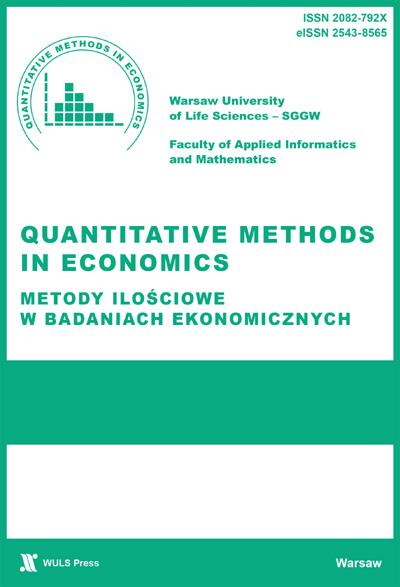Main Article Content
Article Details
Akaike H. (1976) Canonical Correlation Analysis of Time Series and the Use of an Information Criterion. Mathematics in Science and Engineering, 126, 27-96.
Berk J. M., Knot K. H. (2001) Testing for Long Horizon UIP using PPP-based Exchange Rate Expectations. Journal of Banking & Finance, 25(2), 377-391.
Bollerslev T. (1990) Modelling the Coherence in Short-run Nominal Exchange Rates: a Multivariate Generalised ARCH Model. The Review of Economics and Statistics, 72(3), 498-505.
Chinn M. D., Meredith G. (2004) Monetary Policy and Long-horizon Uncovered Interest Parity. IMF staff papers, 51(3), 409-430.
Clarida R., Davis J., Pedersen N. (2009) Currency Carry Trade Regimes: Beyond the Fama regression. Journal of International Money and Finance, 28(8), 1375-1389.
Coudert V., Gex M. (2008) Does Risk Aversion Drive Financial Crises? Testing the Predictive Power of Empirical Indicators. Journal of Empirical Finance, 15(2), 167-184.
Czech K. (2016) Anomalia premii terminowej na rynku jena japońskiego, Wydawnictwo SGGW, Warszawa (in Polish).
Czech K. (2020) Speculative Trading and its Effect on the Forward Premium Puzzle: New Evidence from Japanese Yen Market. Bank i Kredyt, 51(2), 167-188.
Dickey D., Fuller W. A. (1979) Distribution of the Estimators for Time Series Regressions with a Unit Root. Journal of the American Statistical Association, 74(366), 427-431.
Domowitz I., Hakkio C. S. (1985) Conditional Variance and the Risk Premium in the Foreign Exchange Market. Journal of International Economics, 19(1-2), 47-66.
Engel C. (1996) The Forward Discount Anomaly and the Risk Premium: A Survey of Recent Evidence. Journal of Empirical Finance, 3(2), 123-192.
Engle R. F. (1982) Autoregressive Conditional Heteroscedasticity with Estimates of the Variance of United Kingdom Inflation. Econometrica, 50(4), 987-1007.
Engle R. F., Lilien D. M., Robins R. P. (1987) Estimating Time Varying Risk Premia in the Term Structure: The ARCH-M Model. Econometrica, 55(2), 391-407.
Fama E. F. (1984) Forward and Spot Exchange Rates. Journal of Monetary Economics, 14(3), 319-338.
Froot K. A., Thaler R. H. (1990) Anomalies: Foreign Exchange. Journal of Economic Perspectives, 4(3), 179-192.
Hodrick R. J. (1987) The Empirical Evidence on the Efficiency of Forward and Futures Foreign Exchange Markets, Harwood Academic Publishers, Chur, Switzerland.
Hossfeld O., MacDonald R. (2015) Carry Funding and Safe Haven Currencies: A Threshold Regression Approach. Journal of International Money and Finance, 59, 185-202.
Kumar, S. (2019). Does Risk Premium Help Uncover the Uncovered Interest Parity Failure?. Journal of International Financial Markets, Institutions and Money, 63, 101135.
Li D., Ghoshray A., Morley B. (2012) Measuring the Risk Premium in Uncovered Interest Parity using the Component GARCH-M Model. International Review of Economics & Finance, 24, 167-176.
Liu M. H., Margaritis D., Tourani- Rad A. (2012) Risk Appetite, Carry Trade and Exchange Rates. Global Finance Journal, 23(1), 48-63.
Malliaropulos D. (1997) A Multivariate GARCH Model of Risk Premia in Foreign Exchange Markets. Economic Modelling, 14(1), 61-79.
Marquardt D. W. (1963) An Algorithm for Least-squares Estimation of Nonlinear Parameters. Journal of the Society for Industrial and Applied Mathematics, 11(2), 431-441.
McCallum B. T. (1994) A Reconsideration of the Uncovered Interest Parity Relationship. Journal of Monetary Economics, 33(1), 105-132.
Wen X., Cheng H. (2018) Which is the Safe Haven for Emerging Stock Markets, Gold or the US Dollar?. Emerging Markets Review, 35, 69-90.
Whaley R. E. (2009) Understanding the VIX. The Journal of Portfolio Management, 35(3), 98-105.
Downloads
- Katarzyna Czech, TESTING UNCOVERED INTEREST PARITY IN THE PLN/JPY FOREIGN EXCHANGE MARKET: A MARKOV-SWITCHING APPROACH , Metody Ilościowe w Badaniach Ekonomicznych: Tom 18 Nr 1 (2017)
- Joanna Kisielińska, Katarzyna Czech, THE APPLICATION OF REGRESSION ANALYSIS IN TESTING UNCOVERED INTEREST RATE PARIT , Metody Ilościowe w Badaniach Ekonomicznych: Tom 14 Nr 1 (2013)
Publikowane artykuły dostępne są na warunkach Open Access na zasadach licencji Creative Commons CC BY-NC – do celów niekomercyjnych udostępnione materiały mogą być kopiowane, drukowane i rozpowszechniane. Autorzy ponoszą opłatę za opublikowanie artykułu.





